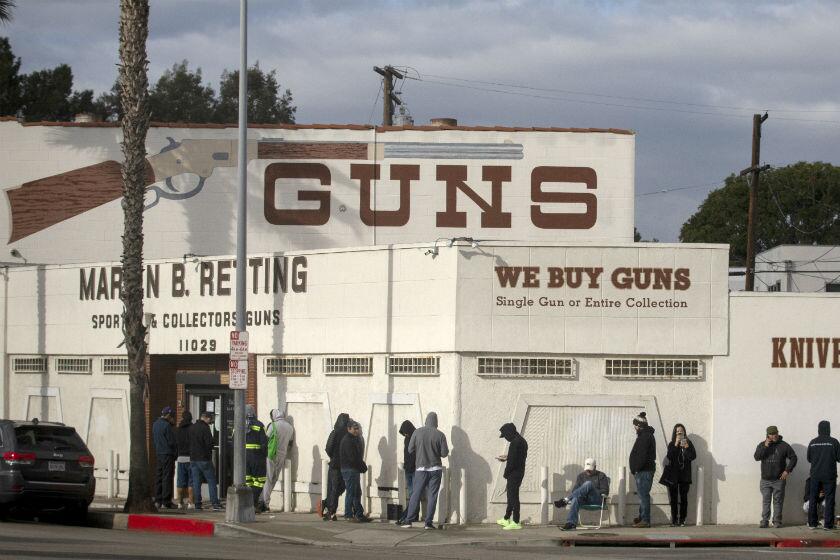The Maine shooting suspect fits the profile. He is American and he has a gun

- Share via
Robert Card, the suspected killer of at least 18 people in shootings at a bowling alley and a restaurant Wednesday night in Lewiston, Maine, reportedly served as a military reservist. Card, found dead on Friday night from an apparent self-inflicted gunshot wound, had what‘s been described in news stories as a “run-in” with officials at a National Guard training facility several months ago. Family members said he had been “hearing voices” when he was fitted for high-powered hearing aids, and he was reported to have received psychiatric treatment.
It’s human nature at a time like this to pick through bits of incomplete information in search of patterns that characterize mass shooters to understand what kind of person commits such horrendous crimes and why.
This country is exactly the place for hateful, murderous, suicidal gun violence, because this is the place for millions upon millions of guns and the bizarre American delusion that the more of them we have, the safer and freer we are.
Perhaps the “typical” mass killer is a military man? It is true that there have been high-profile shooters with military backgrounds, like the ex-Marine who gunned down 12 innocent people in a Thousand Oaks bar in 2018 and the Air Force veteran who killed 25 people and a fetus at a church in Sutherland Springs, Texas, in 2017. But that tenuous connection plays into false stereotypes about military personnel and does not account for the large number of incidents in which the killer has no military background.
Are mass shooters psychotic? It is oddly comforting to think so, especially for those who resist gun control. “Mental illness and hatred pulls the trigger, not the gun,” then-President Trump said in 2019, after shootings in El Paso and in Dayton, Ohio. But a majority of mass killers have never been diagnosed with any psychiatric disorders or undergone mental health treatment. And while the ranks of such killers clearly include racists and conspiracy theorists, they also include people with purely personal grievances, and plenty who had no discernible motive of any kind.
We may not know the motive for the Monterey Park attack amid Lunar New Year festivities, but we know how the mass killer committed his act: He had a gun.
Some mass shooters perpetrate their violence in small towns, some in huge cities, some at movie theaters or dance studios — or newspaper offices, Christmas parties, parades, bars, elementary schools, universities, grocery stores, churches, bowling alleys. The vast majority are men, but they are young and old, and white, Latino, Black, Asian.
It’s hard to find much in common among the 72-year-old man who killed 11 people in Monterey Park in January; the six people aged 15 to 20 who killed four people at a Sweet 16 birthday party in Dadeville, Ala., in April; the 33-year-old man who killed eight people at an Allen, Texas, shopping center in May; and the 59-year-old retired police sergeant who killed four in Trabuco Canyon in August — or any of the other perpetrators of horrid mass shootings in 2023.
Perhaps it’s the fate of the United States to watch its soul die along with the 19 students and two adults shot to death Tuesday at an elementary school in Uvalde, Texas.
Researchers continue to seek common traits. They have found that many shooters act while in emotional crisis, but that generally they don’t suddenly “snap.” They plan. They nurse their anger. They act.
But there is no consistent profile. Perpetrators are Americans of all stripes, committing a peculiarly American crime.
The decision striking down a New York law that restricts who can carry a concealed handgun could doom some of California’s smart gun safety laws.
The one thing they have in common is guns, which are more plentiful than ever in the United States. The COVID-19 pandemic and unrest in the wake of George Floyd‘s murder in 2020 helped spur a huge spike in gun sales.
At the same time, the U.S. Supreme Court has been rolling back weapons restrictions, in effect turning the 2nd Amendment into a national suicide pact. Next month, the court will hear arguments in a case challenging a federal law barring a person under a domestic violence restraining order from possessing firearms. The case will concern the court’s bizarre dictate that no restriction is valid if it doesn’t have an 18th century precedent.
Even a domestic violence restraining order isn’t justification to stop dangerous people from carrying guns? The bizarre 5th Circuit Court ruling and others like it will be the death of us.
Domestic abusers are one of the few categories of people who experience tells us are more likely to commit gun violence. If we can no longer protect ourselves even from them, we will join the people of Lewiston and too many other communities to name, locked down in our homes, in fear of guns and the wide variety of our fellow Americans ready to use them against us.
More to Read
A cure for the common opinion
Get thought-provoking perspectives with our weekly newsletter.
You may occasionally receive promotional content from the Los Angeles Times.














